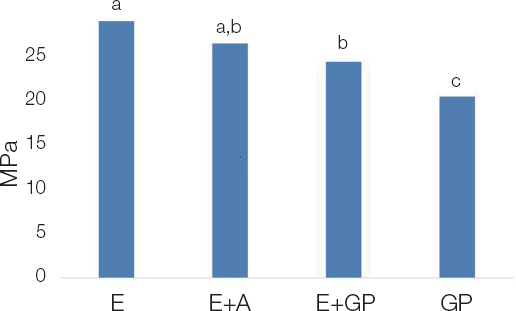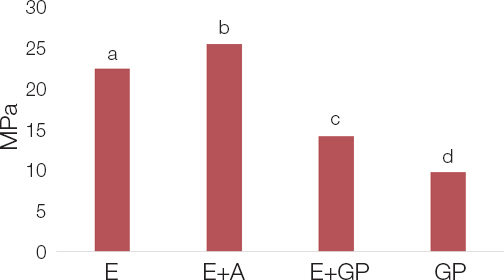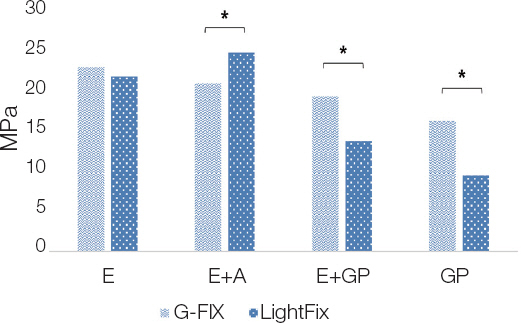J Dent Rehabil Appl Sci.
2019 Jun;35(2):72-80. 10.14368/jdras.2019.35.2.72.
Comparison of adhesive strength of resinous teeth splinting materials according to enamel surface treatment
- Affiliations
-
- 1Department of Conservative Dentistry, College of Dentistry, Gangneung-Wonju National University School of Dentistry, Gangneung, Republic of Korea. drbozon@gwnu.ac.kr
- KMID: 2451754
- DOI: http://doi.org/10.14368/jdras.2019.35.2.72
Abstract
- PURPOSE
The purpose of this study is to compare and analyze the shear bond strength and fracture pattern in different enamel tooth surface treatments for resin splinting materials.
MATERIALS AND METHODS
G-FIX and LightFix were used as tooth splinting materials. Twenty bovine mandibular incisors were used for the preparation of the specimens. The exposed enamel surface was separated into four parts. Each tooth was treated with 37% phosphoric acid, 37% phosphoric acid + adhesive resin, 37% phosphoric acid + G-premio bond, and G-premio bond for each fraction. Shear bond strength was measured using a universal testing machine. After measuring the shear bond strength, the fractured surface of the specimen was magnified with a microscope to observe the fracture pattern. Two-way ANOVA was used to verify the interaction between the material and the surface treatment method. Oneway ANOVA was used for comparison between the surface treatment methods of each material and post-hoc test was conducted with Scheffe's test. An independent t-test was conducted to compare shear bond strengths between materials in each surface treatment method. All statistics were conducted at 95% significance level.
RESULTS
G-FIX, a tooth splinting resin, showed similar shear bonding strength when additional adhesive resins were used when material was applied after only acid etching, and LightFix showed the highest shear bonding strength when additional adhesive resins were used after the acid etching. In addition, both G-FIX and LightFix showed the lowest shear bond strength when only self-etching adhesive was applied without additional acid etching. Verification of interactions observed interconnection between resins and surface treatment methods. Most of the mixed failure was observed in all counties.
CONCLUSION
When using G-FIX and LightFix, which are tooth-splinting materials, it is considered that sufficient adhesion will be achieved even after applying only acid etching as instructed by the manufacturer.
Figure
Reference
-
References
1. Liu X, Zhang Y, Zhou Z, Ma S. Retrospective study of combined splinting restorations in the aesthetic zone of periodontal patients. Br Dent J. 2016; 220:241–7. DOI: 10.1038/sj.bdj.2016.178. PMID: 26964599. PMCID: PMCPMC5565939.2. Bernal G, Carvajal JC, Munoz-Viveros CA. A review of the clinical management of mobile teeth. J Contemp Dent Prac. 2002; 3:10–22. PMID: 12444399.3. Mazzoleni S, Meschia G, Cortesi R, Bressan E, Tomasi C, Ferro R, Stellini E. In vitro comparison of the flexibility of different splint systems used in dental traumatology. Dent Traumatol. 2010; 26:30–6. DOI: 10.1111/j.1600-9657.2009.00843.x. PMID: 20089059.4. Yoo JI, Kim SY, Batbayar B, Kim JW, Park SH, Cho KM. Comparison of flexural strength and modulus of elasticity in several resinous teeth splinting materials. J Dent Rehabil Appl Sci. 2016; 32:169–75. DOI: 10.14368/jdras.2016.32.3.169.5. Wood M, Kern M, Thompson VP, Romberg E. Ten-year clinical and microscopic evaluation of resin-bonded restorations. Quintessence Int. 1996; 27:803–7. PMID: 9452672.6. Buonocore MG. A simple method of increasing the adhesion of acrylic filling materials to enamel surfaces. J Dent Res. 1955; 34:849–53. DOI: 10.1177/00220345550340060801. PMID: 13271655.7. Ando S, Watanabe T, Tsubota K, Yoshida T, Irokawa A, Takamizawa T, Kurokawa H, Miyazaki M. Effect of adhesive application methods on bond strength to bovine enamel. J Oral Sci. 2008; 50:181–6. DOI: 10.2334/josnusd.50.181. PMID: 18587208.8. Bermudez L, Wajdowicz M, Ashcraft-Olmscheid D, Vandewalle K. Effect of Selective Etch on the Bond Strength of Composite to Enamel Using a Silorane Adhesive. Oper Dent. 2015; 40:E242–9. DOI: 10.2341/14-311-L. PMID: 26244264.9. Oskoee SS, Bahari M, Kimyai S, Navimipour EJ, Firouzmandi M. Shear bond strength of self-etching adhesive systems with different pH values to bleached and/or CPP-ACP-treated enamel. J Adhes Dent. 2012; 14:447–52. DOI: 10.3290/j.jad.a23316. PMID: 22518383.10. Fowler CS, Swartz ML, Moore BK, Rhodes BF. Influence of selected variables on adhesion testing. Dent Mater. 1992; 8:265–9. DOI: 10.1016/0109-5641(92)90097-V. PMID: 1291395.11. Edmunds DH, Whittaker DK, Green RM. Suitability of human, bovine, equine, and ovine tooth enamel for studies of artificial bacterial carious lesions. Caries Res. 1988; 22:327–36. DOI: 10.1159/000261132. PMID: 3214846.12. Soares FZ, Follak A, da Rosa LS, Montagner AF, Lenzi TL, Rocha RO. Bovine tooth is a substitute for human tooth on bond strength studies:A systematic review and meta-analysis of in vitro studies. Dent Mater. 2016; 32:1385–93. DOI: 10.1016/j.dental.2016.09.019. PMID: 27692438.13. Reis AF, Giannini M, Kavaguchi A, Soares CJ, Line SR. Comparison of microtensile bond strength to enamel and dentin of human, bovine, and porcine teeth. J Adhes Dent. 2004; 6:117–21. PMID: 15293420.14. Shimada Y, Senawongse P, Harnirattisai C, Burrow MF, Nakaoki Y, Tagami J. Bond strength of two adhesive systems to primary and permanent enamel. Oper Dent. 2002; 27:403–9. PMID: 12120779.15. Sano H, Shono T, Sonoda H, Takatsu T, Ciucchi B, Carvalho R, Pashley DH. Relationship between surface area for adhesion and tensile bond strength-evaluation of a micro-tensile bond test. Dent Mater. 1994; 10:236–40. DOI: 10.1016/0109-5641(94)90067-1. PMID: 7664990.16. Pashley DH, Carvalho RM. Dentine permeability and dentine adhesion. J Dent. 1997; 25:355–72. DOI: 10.1016/S0300-5712(96)00057-7. PMID: 9241954.17. Hayakawa T, Kikutake K, Nemoto K. Influence of self-etching primer treatment on the adhesion of resin composite to polished dentin and enamel. Dent Mater. 1998; 14:99–105. DOI: 10.1016/S0109-5641(98)00015-3. PMID: 10023198.18. Yoshida Y, Nagakane K, Fukuda R, Nakayama Y, Okazaki M, Shintani H, Inoue S, Tagawa Y, Suzuki K, De Munck J, Van Meerbeek B. Comparative study on adhesive performance of functional monomers. J Dent Res. 2004; 83:454–8. DOI: 10.1177/154405910408300604. PMID: 15153451.19. Erickson RL, Barkmeier WW, Kimmes NS. Bond strength of self-etch adhesives to pre-etched enamel. Dent Mater. 2009; 25:1187–94. DOI: 10.1016/j.dental.2009.04.004. PMID: 19473695.20. Miguez PA, Castro PS, Nunes MF, Walter R, Pereira PN. Effect of acid-etching on the enamel bond of two self-etching systems. J Adhes Dent. 2003; 5:107–12. PMID: 14964677.21. Luhrs AK, Guhr S, Schilke R, Borchers L, Geurtsen W, Gunay H. Shear bond strength of self-etch adhesives to enamel with additional phosphoric acid etching. Oper Dent. 2008; 33:155–62. DOI: 10.2341/07-63. PMID: 18435189.22. Barkmeier WW, Erickson RL, Kimmes NS, Latta MA, Wilwerding TM. Effect of enamel etching time on roughness and bond strength. Oper Dent. 2009; 34:217–22. DOI: 10.2341/08-72. PMID: 19363978.23. Park BY, Kim SY, Kim JW, Park SH, Cho KM. Influence of water absorption on flexural strength and elastic modulus in several resinous teeth splinting materials. J Dent Rehabil Appl Sci. 2018; 34:72–9. DOI: 10.14368/jdras.2018.34.2.72.24. Hannig M, Reinhardt KJ, Bott B. Self-etching primer vs phosphoric acid:an alternative concept for composite-to-enamel bonding. Oper Dent. 1999; 24:172–80. PMID: 10530279.25. Tay FR, King NM, Suh BI, Pashley DH. Effect of delayed activation of light-cured resin composites on bonding of all-in-one adhesives. J Adhes Dent. 2001; 3:207–25. PMID: 11803709.26. Ferrari M, Mason PN, Vichi A, Davidson CL. Role of hybridization on marginal leakage and bond strength. Am J Dent. 2000; 13:329–36. PMID: 11764128.27. Van Meerbeek B, Yoshihara K, Yoshida Y, Mine A, De Munck J, Van Landuyt KL. State of the art of self-etch adhesives. Dent Mater. 2011; 27:17–28. DOI: 10.1016/j.dental.2010.10.023. PMID: 21109301.
- Full Text Links
- Actions
-
Cited
- CITED
-
- Close
- Share
- Similar articles
-
- Bond strength according to the adhesive type and the distance between enamel surface and resin base in indirect bonding
- A Comparison of shear Bonding Strength with Polyacrylic acid and Phosphoric acid Enamel Surface Conditioning
- Tooth surface treatment strategies for adhesive cementation
- Shear Bond Strength of a 3-in-1 Flowable Composite Resin to Primary Teeth
- Effect of applying adhesive after enamel etching on the shear bond strength of orthodontic brackets using light curing resin cements




